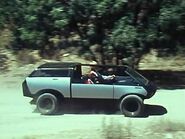mNo edit summary Tag: rte-source |
No edit summary Tag: sourceedit |
||
| Line 1: | Line 1: | ||
| + | {{Vehicle Stats |
||
| ⚫ | |||
| + | |Name = ARC Heavy Explorer |
||
| + | |Image = [[File:ARK_01.jpg]] |
||
| + | |Manu = Advanced Research Concepts |
||
| + | |Cost = 55,000 |
||
| + | |Rent = 450 |
||
| + | |Daily = 375 |
||
| + | |Pro = Ground |
||
| + | |TopS = 125 |
||
| + | |TopK = 75 |
||
| + | |TurnS = 50 |
||
| + | |TurnK = 30 |
||
| + | |AcS = 24 |
||
| + | |DcS = 18 |
||
| + | |Power = x1 Type 1 power generator plus x2 Type 3 parabattery |
||
| + | |Rng = unlimited on generator, on batteries 2,000 |
||
| + | |Fuel = 2 |
||
| + | |Crew = 1 |
||
| + | |Pass = 3 |
||
| + | |Cargo = 500kg, 5 cubic meters |
||
| + | |Weap = x1 heavy laser (nose) |
||
| + | |Armor = Inertia Screen, Albedo coating |
||
| + | |Equip = Cameras, environmental sensors, laboratory equipment, food synthesizer, radar, radiophone |
||
| + | }} |
||
| ⚫ | The '''ARC Heavy Explorer''' (known affectionately by their operators as an "Ark") is one of the most sophisticated mobile laboratories to be found anywhere in Frontier space. It certainly is one of the most costly, much more so than regular Explorer types. Arks are capable of providing a crew of four (driver and 3 passenger/mission specialists) with all the needed facilities to conduct basic research/survey work for extended periods of time without outside support. |
||
Rugged and reliable, Arks can be maintained with on-board micro-fabrication equipment except for the most extreme damage to major components. Food synthesis and water reclamation/purification systems virtually eliminate the need for external resupply in any environment where liquid water and basic organic materials exist, though the food thus produced will never be considered gourmet quality. |
Rugged and reliable, Arks can be maintained with on-board micro-fabrication equipment except for the most extreme damage to major components. Food synthesis and water reclamation/purification systems virtually eliminate the need for external resupply in any environment where liquid water and basic organic materials exist, though the food thus produced will never be considered gourmet quality. |
||
Revision as of 08:53, 3 February 2016
| ARC Heavy Explorer | |

| |
| Purchasing | |
| Manufacturer: | Advanced Research Concepts |
| Cost to Own: | 55,000 Cr |
| Rental Cost: | 450 Cr plus 375 Cr/day |
| Transmission | |
| Propulsion Type: | Ground |
| Top Speed: | 125m/t (75kph) |
| Turn Speed: | 50m/t (30kph) |
| Acceleration Speed: | 24m/t |
| Deceleration Speed: | 18m/t |
| Power | |
| Powerplant: | x1 Type 1 power generator plus x2 Type 3 parabattery |
| Range: | unlimited on generator, on batteries 2,000km |
| Fuel Economy: | 2 SEU/km |
| Capacity | |
| Crew: | 1 |
| Passengers: | 3 |
| Cargo Limit: | 500kg, 5 cubic meters |
| Armaments: | x1 heavy laser (nose) |
| Armor: | Inertia Screen, Albedo coating |
| Other Equipment: | Cameras, environmental sensors, laboratory equipment, food synthesizer, radar, radiophone |
The ARC Heavy Explorer (known affectionately by their operators as an "Ark") is one of the most sophisticated mobile laboratories to be found anywhere in Frontier space. It certainly is one of the most costly, much more so than regular Explorer types. Arks are capable of providing a crew of four (driver and 3 passenger/mission specialists) with all the needed facilities to conduct basic research/survey work for extended periods of time without outside support.
Rugged and reliable, Arks can be maintained with on-board micro-fabrication equipment except for the most extreme damage to major components. Food synthesis and water reclamation/purification systems virtually eliminate the need for external resupply in any environment where liquid water and basic organic materials exist, though the food thus produced will never be considered gourmet quality.
Arks are powered by a Type 1 power generator supported by two Type 3 parabatteries. The power source is typically either solar, or a small fusion power pack. This permits the vehicle to run at top speed while still charging one battery (the other being an emergency reserve). With judicious use, this arrangement permits the vehicle to operate around the clock if required.
Arks mount a full range of omni-directional cameras, basic environmental sensors measuring radiation, air quality, etc, as well as a short-range radar (range ~200km). They are radiation resistant, and can be fully sealed against dangerous atmospheric conditions, and for fording purposes.
Arks typically carry either one ground car or two ground cycles (informally known as Roamers) as auxiliary transport. (Use normal stats for the cycles. Reduce the passenger capacity of the ground car to 2), as well as a jetpack or other single-person aerial conveyance for impassable terrain.
Arks are protected by Inertia screens and an Albedo coating. A nose-mounted industrial/mining laser is included for helping remove travel obstacles (use Heavy Laser stats).
Contributed by ChrisDonovan. Inspired by Ark II television series, which belongs to Filmation Studios and/or CBS.

